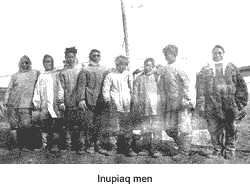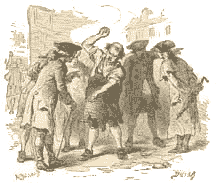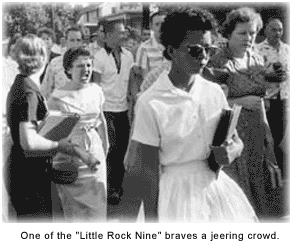Historical Eras
The U.S. History Framework, a guiding document for teaching history to students in the U.S., assigns eight chronological periods in American and U.S. history: Beginnings, Colonization, Revolution, Expansion and Reform, Civil War and Reconstruction, Development of Modern America, World Wars, and Contemporary America. Within each of these periods, learners to this website will find links to important eras, events, and people in the history of the Americas.
 BEGINNINGS
BEGINNINGS
- To 1630 Early America
Most authorities believe that the Western hemisphere was populated at the end of the last ice age when a lowered ocean level exposed a land bridge that Asian peoples traversed to North America.... Continue Reading
COLONIZATION, SETTLEMENT, & COMMUNITIES
- 1630 - 1763: The Colonial Period
The Colonial Period in U.S. history was a time of settlement, discovery, and hardship. This era is marked by European colonization and expansion into the eastern edges of North America. Colonists ofte... Continue Reading
 REVOLUTION & THE NEW NATION
REVOLUTION & THE NEW NATION
- 1763 - 1783: Revolutionary America
As a colonial power, England considered America’s colonies as possessions that existed to benefit the mother country. America was a source of food and raw materials and was also a market for finished ... Continue Reading
- 1783 - 1815: The Young Republic
After war with England, the founders focused on establishing a form of governance for the new country and expanding its borders. The Louisiana Purchase doubled the area of the U.S. and the area’s reso... Continue Reading
EXPANSION & REFORM
- 1815 - 1860: Expansion, Political Reform, and First Industrial Revolution
As the new nation settled its governance, it continued to expand geographically. Some coined the early 1800s as the “Era of Good Feelings,” due to an apparent lack of political strife. The U.S. philos... Continue Reading
 CRISIS OF THE UNION: CIVIL WAR & RECONSTRUCTION
CRISIS OF THE UNION: CIVIL WAR & RECONSTRUCTION
- 1830 - 1876: Sectional Controversy, War, and Reconstruction
The period before, during, and after the Civil War was a time of great upheaval in the course of the fledgling country. Leading up to the Civil War, starting with the drafting of the Constitution, the... Continue Reading
DEVELOPMENT OF MODERN AMERICA
- 1871 - 1914: Second Industrial Revolution
The Second Industrial Revolution was a phase of rapid technological advance and widespread adoption. Telegraph and railroad lines, gas and water supplies, and sewage systems were built across the coun... Continue Reading
- 1880 - 1920: Political Reform II
The era of politics after the Civil War became more dynamic as Americans struggled to determine the direction of the country into the 20th century. New political parties, such as the Populists and Pro... Continue Reading
MODERN AMERICA & WORLD WARS

- 1914 - 1933: War, Prosperity, and the Great Depression
World War I has been called the first modern war due to the widespread use of new technologies such as machine guns, airplanes, land vehicles, and radio communications. The war exacted heavy human cas... Continue Reading
- 1933 - 1945: New Deal and World War II
Franklin D. Roosevelt quickly set to economic reform when he assumed the office of president in 1933. His New Deal programs—public work projects, financial reforms, and regulations—were enacted to pro... Continue Reading
CONTEMPORARY AMERICA
- 1945 - 1960: Postwar America
The era after World War II marks the beginning of Contemporary America: an age of rapid communication, globalism, increasing reliance on science, a struggle for civil rights and equality, and the noti... Continue Reading

- 1960 - 1980: Civil Unrest & Social Reforms
The Vietnam era, which ran from the 1960s into the 70s, was not just a time of war for the U.S., but also a time of significant civil unrest. John F. Kennedy came into the presidential office in 1961 ... Continue Reading
- 1980 - 2000: End of the Century
The 1980s saw the rise of conservatism in America, “trickle-down” economics, and the end of the Cold War—symbolized most powerfully when the Berlin Wall was torn down. The HIV/AIDs epidemic caused dev... Continue Reading
- 2001 - 2016: New Millenium
In the U.S., the beginning of the new millennium was marred by the tragedy on September 11, 2001, when militants associated with an extremist group, al Quada, hijacked four commercial airplanes and fl... Continue Reading
- 2017- present: Pandemic and Cultural Change
The present period is currently defined by COVID-19, the pandemic that swept across the world in early 2020. COVID-19 was one of the fastest spreading and widespread pandemics since the Spanish flu mo... Continue Reading
SOURCES & FURTHER READING
U.S. History Framework for the National Assessment of Educational Progress (2006). National Assessment Governing Board, U.S. Department of Education. Washington, DC.
www.nces.ed.gov/nationsreportcard/ushistory
 BEGINNINGS
BEGINNINGS
 REVOLUTION & THE NEW NATION
REVOLUTION & THE NEW NATION
 CRISIS OF THE UNION: CIVIL WAR & RECONSTRUCTION
CRISIS OF THE UNION: CIVIL WAR & RECONSTRUCTION

